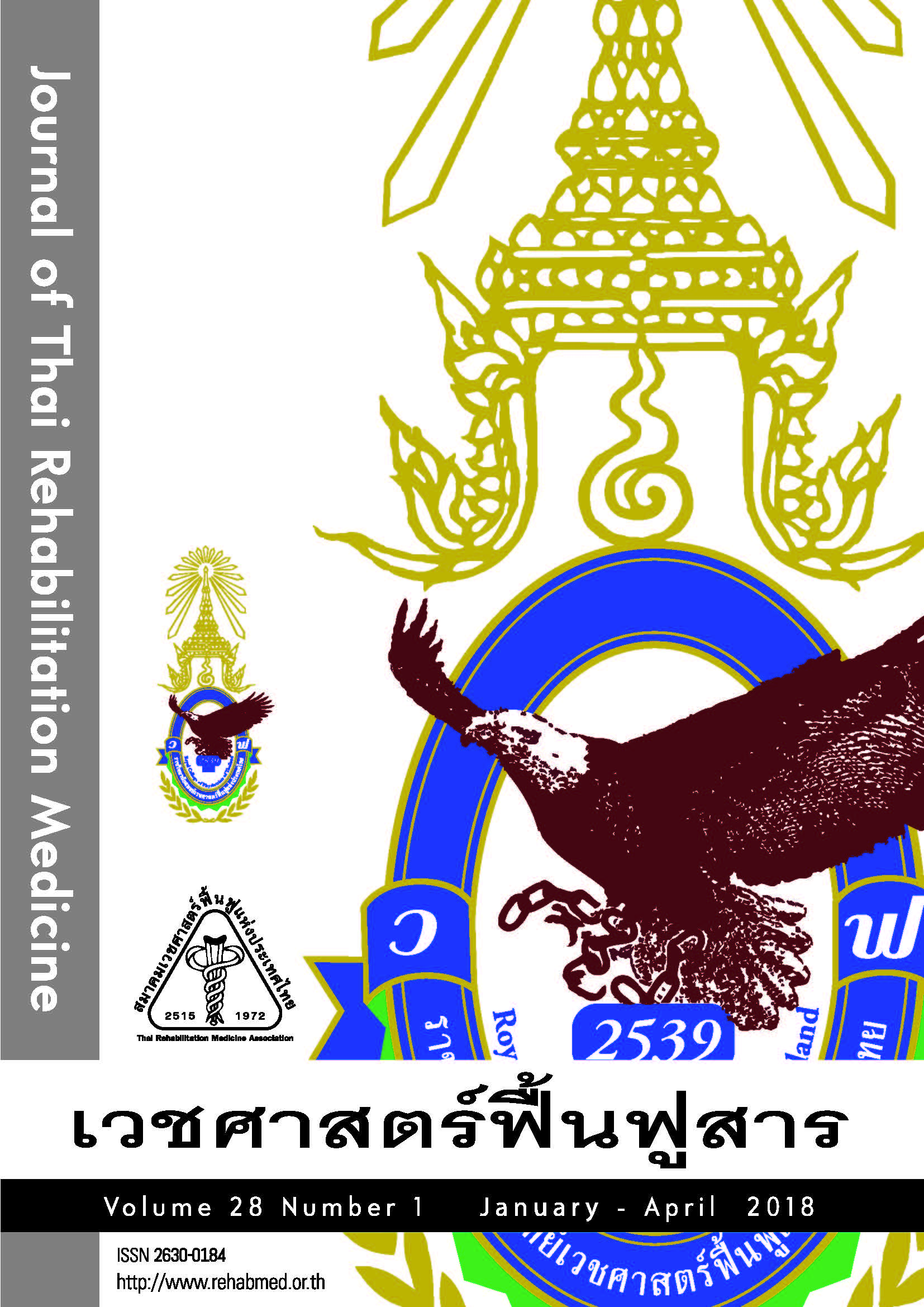ความสัมพันธ์ระหว่างระดับความรุนแรงจากการตรวจไฟฟ้าวินิจฉัยและภาวะปวดเหตุพยาธิสภาพประสาทในกลุ่มอาการเส้นประสาทมีเดียนถูกกดทับในอุโมงค์ข้อมือ
ความสัมพันธ์ระหว่างระดับความรุนแรงจากการตรวจไฟฟ้าวินิจฉัยและภาวะปวดเหตุพยาธิสภาพประสาทในกลุ่มอาการเส้นประสาทมีเดียนถูกกดทับในอุโมงค์ข้อมือ
Keywords:
neuropathic pain, carpal tunnel syndrome, electrodiagnosis, Thai DN4 questionnaireAbstract
Objectives: To determine prevalence of neuropathic pain (NeuP) and to investigate the relationship between the presence of neuropathic pain assessed by the Thai language of the NeuP diagnostic questionnaire (Thai DN4) and electrodiagnostic severity in patients with carpal tunnel syndrome (CTS).
Study design: Descriptive cross-sectional study.
Setting: Electrodiagnostic clinic, Saraburi Hospital.
Subjects: Ninety-one patients diagnosed with CTS.
Methods: All hands were assessed with the Thai DN4 questionnaire. A score of four or more was defined as pain dominated with neuropathic mechanisms. The severity of CTS was diagnosed as minimal, mild, moderate, severe, or extremely severe according to the results of the median nerve conduction studies (NCSs).
Results: Ninety-one patients with a total of 160 hands were diagnosed with CTS (13 [14.29%] men and 78 [85.71%] women). According to the severity of CTS, four hands (2.5%) were cate-gorized as minimal, 36 (22.5%) as mild, 95 (59.38%) as moderate, 14 (8.75%) as severe and 11 (6.88%) as extremely severe. Prevalence of NeuP was 45.63% and there was a statistically significant relation between NeuP assessed with the Thai DN4 questionnaire and electrodiagnostic severity in patients with CTS (p < 0.05), the more severe degree of CTS, the increasing the percentage of NeuP.
Conclusion: In patients with CTS, the prevalence of NeuP assessed by the Thai DN4 questionnaire was 45.63% and there was a statistically significant relation between the presence of NeuP and electrodiagnostic severity of CTS.
References
2. de Krom MC, Knipschild PG, Kester AD, Thijs CT, Boekkooi PF, Spaans F. Carpal tunnel syndrome: prevalence in the general population. J Clin Epidem. 1992;45:373–6.
3. Atroshi I, Gummesson C, Johnsson R, Ornstein E, Ranstam J, Rosen I. Prevalence of carpal tunnel syndrome in a general population. JAMA. 1999;282:153–8.
4. Aroori S, Spence R. Carpal tunnel syndrome. Ulster Med J. 2008; 77:6–17.
5. Freilich AM, Chhabra AB. Diagnosis and pathophysiology of carpal tunnel syndrome. Curr Opin Orthop. 2007;18:347-51.
6. Sternbach G. The carpal tunnel syndrome. J Emergen Med. 1999; 17:519-23.
7. Dumitru D, Zwarts MJ, Amato AA. Focal peripheral neuropathies. Electrodiagnostic medicine. 2nd ed. 2002; 1062.
8. Kuwabara S. Carpal tunnel syndrome: Demyelinative or ischemic conduction block? Clin Neurophysiol. 2009;120:223-4.
9. Werner RA, Franzblau A, Albers JW, Armstrong TJ. Influence of body mass index and work activity on the prevalence of median mononeuropathy at the wrist. Occup Environ Med. 1997;54:268-71.
10. Kouyoumdjian JA, Morita MD, Rocha PR, Miranda RC, Gouveia GM. Body mass index and carpal tunnel syndrome. ArqNeuropsiquiatr. 2000;58:252-56.
11. Moghtaderi A, Izadi S, Sharafadinzadeh N. An evaluationof gender, body mass index, wrist circumference and wrist ratio as independent risk factors for carpal tunnel syndrome. ActaNeurolScand 2005;112:375-79.
12. Rempel D, Evanoff B, Amadio PC, de Krom M, Franklin G, Franzblau A, et al. Consensus criteria for the classification of carpal tunnel syndrome in epidemiologic studies. Am J Public Health. 1998; 88:1447-51.
13. Jablecki CK, Andary MT, Floeter MK, Miller RG, Quartly CA, Vennix MJ, et al. American Association of Electrodiagnostic Medicine; American Academy of Neurology; American Academy of Physical Medicine and Rehabilitation. Practice parameter: electrodiagnostic studies in carpal tunnel syndrome. Report of the American Association of Electrodiagnostic Medicine, American Academy of Neurology, and the American Academy of Physical Medicine and Rehabilitation. Neurology. 2002;58:1589-92.
14. Keith MW, Masear V, Chung K, Maupin K, Andary M, Amadio PC, et al. Diagnosis of carpal tunnel syndrome. J Am AcadOrthop Surg. 2009;17:389-96.
15. Padua L, Padua R, Lo Monaco M, Aprile I, Tonali P. Multiperspective assessment of carpal tunnel syndrome: a multicenter study. Italian CTS Study Group. Neurology. 1999;53:1654-9.
16. You H, Simmons Z, Freivalds A, Kothari MJ, Naidu SH. Relationships between clinical symptom severity scales and nerve conduction measures in carpal tunnel syndrome. Muscle Nerve. 1999; 22:497-501.
17. Chaudakshetrin P, Prateepavanich P, Chira-Adisai W, Tassanawipas W, Leechavengvongs S, Kitisomprayoonkul W. Cross-culturaladaption to the Thai language of the neuropathic pain diagnostic questionare (DN4). J Med Assoc Thai. 2007;90:1860-5.
18. Kuhlman KA, Hennessey WJ. Sensitivity and specificity of carpal tunnel syndrome. Am J Phys Med Rehabil. 1997;76:451-7.
19. Boland RA, Kiernan MC. Assessing the accuracy of a combination of clinical tests for identifying carpal tunnel syndrome. J ClinNeurosci 2009;16:929-33.
20. Mondelli M, Passero S, Giannini F. Provocative tests in different stages of carpal tunnel syndrome. ClinNeurolNeurosurg 2001; 103:178-83.
21. Tetro AM, Evanoff BA, Hollstien SB, Gelberman RH. A new provocative test for carpal tunnel syndrome. J Bone Joint Surg [Br]. 1998;80:493-8.
22. Leelasamran W, Permsirivanich W, Boonmeprakob A. Nerve conduction studies of median nerve in normal subjects. Songkhla Med J. 2005;23:423-8.
23. Padua L, Lomonaco M, Gregori B, Valente EM, Padua R, Tonali P. Neurophysiological classification and sensitivity in 500 carpal tunnel syndrome hands. Acta Neurol Scand. 1997;96:211-7.
24. Gary JB. Chronic pain due to peripheral nerve damage: an overview. In: Fields HL, Liebeskind JC, editors. Progress in Pain Research and Management. Vol. 1. Seattle: IASP Press; 1994a. p. 51-9.
25. Gürsoy AE, Kolukısa M, Yıldız GB. Relationship between electrodiagnostic severity and neuropathic pain assessed by the LANSS pain scale in carpal tunnel syndrome. Neuropsychiatr DisTreat. 2013;9:65–71.
26. Oncel C, Bir LS, Sanal E. The relationship between electrodiagnostic severity and Washington Neuropathic Pain Scale in patients with carpal tunnel syndrome. Agri. 2009;21:146-8.
27. Truini A, Padua L, Biasiotta A, Caliandro P, Pazzaglia C, Galeotti F, et al. Differential involvement of A-delta and A-beta fibres in neuropathic pain related to carpal tunnel syndrome. Pain. 2009; 145:105-9.
28. Khanittanuphong P, Leelasamran W, Boonmeeprakob A. Diagnostic accuracy of provocative tests in the diagnosis of carpal tunnel syndrome. J Thai Rehabil Med. 2011;21:56-62.
29. Thai Association for the study of pain. Clinical practice guideline for neuropathic pain. Bangkok: Beyond Enterprise; 2008.
30. Sonohata M, Tsuruta T, Mine H, Asami A, Ishii H, Tsunoda K, et al. The effect of carpal tunnel release on neuropathic pain in carpal tunnel syndrome. Pain Res Manag. 2017;2017:8098473.






